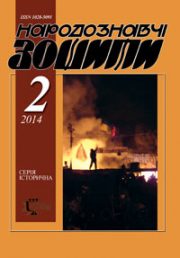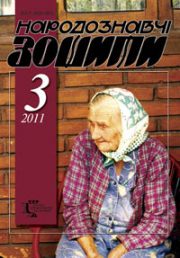The Ethnology Notebooks. 2021. # 2 (158), P. 303—313
УДК398.344:728.9 (477.41/.42)
DOI https://doi.org/10.15407/nz2021.02.303
Roman RADOVYCH
- ORCID ID: http://orcid.org/0000-0002-1900-8948
- Doctorof Sciences in History, Senior Researcher
- in the Department of Historical Ethnology
- of the Institute of Ethnology
- of the National Academy of Sciences of Ukraine,
- Svobody Avenue, 15, 79000,Lviv, Ukraine.
- e-mail: radovychroman@gmail.com
SPECIFICS OF SELECTION AND LOGGING OF BUILDING WOOD IN THE EASTERN POLISSIA
The process of selection and logging of construction timber was one of the most important stages in the set of measures that accompanied the construction of new housing. The strength and durability of the construction structure, its thermal properties, etc. largely depended on the correctly selected, timely felled and properly prepared wood. Although the issue of selection and logging of wood in the field of folk construction both in Polissia and other ethnographic regions of Ukraine (including the Carpathian region) was covered in some explorations and sections of monographs, materials from Eastern Polissia are either completely absent or presented rather vaguely. In fact, this determines the relevance of the proposed article. The author aims to find out the peculiarities of the selection and logging of building timber in Eastern Polissia, to identify common Polissia`n features and local specifics. The object of research is traditional construction, and the subject is construction wood. The methodological basis of the study is the principle of historicism in combination with elements of structural and functional analysis and the use of basic methods of ethnological science: typological, comprehensive and retrospective analysis, historical reconstruction and more. The study area covers part of the ethnographic region of Eastern Polissia (with in the Chernihiv region), which is part of the Polissia historical and ethnographic region.
In Eastern Polissia, as everywhere in the Polissia region, housing was built in blockhouse technology. Pine was the main species of wood which the walls were made of. In addition, they used oak, alder, aspen, rarely — linden. Oak wood was usually used to make the lower joisiting of the log house — foundations and foundation piles. Given the fact that pine there was the main breed that was used to build the walls of housing in the XIX — early XX centuries, it was selected with special meticulousness. The main indicators that determined the construction qualities of pine were the size of the core, its resin and density of annual rings. Aspen and alder wood also had high construction performance. Timber was logged in the autumn-winter period.
Polissia’n builders, when selecting construction timber, were also guided by certain ritual and customary prohibitions (beliefs, warnings, etc.), in addition to the purely practical properties of wood. Avoid using trees that have dried on stumps, which have been struck by thunder, broken or blown away by the wind, etc. On the other hand, warn about trees with natural anomalies here were recorded rarely.
Keywords: Eastern Polissia, national construction, wood, pine, oak, alder, aspen.
REFERENCES
- Radovych, R. (2013). Specifics of selection and harvesting of construction timber in Western Polissya. The Ethnology Notebooks, 3, 398—410 [in Ukrainian].
- Radovych, R. (1998). Selection and harvesting of timber in the Right Bank Polissya. The Ethnology Notebooks, 1, 54—65 [in Ukrainian].
- Radovych, R. (2012). Features of choice and methods of timber harvesting in Rivne Polissya. Collection of scientific works of DNCZKSTK (Issue 1, pp. 86—108). Kyiv: DNCZKSTK [in Ukrainian].
- Radovych, R. (2009). The specifics of the choice of construction pine in Rokytnia region. Polissya studies in folklore-ethnographic and literary-artistic research (Pp. 119—126). Rivne [in Ukrainian].
- Radovych, R. (2009). Selection and procurement of construction timber in the west of Halych Boykivshchyna (based on materials from Starosambir district of Lviv region). Fortress: a collection of the reserve «Tustan» (Vol. 1, pp. 522—530). Lviv: Kamula [in Ukrainian].
- Taras, Ya. (1996). Choice of place and tree for the construction of a house in Polissya (Based on the materials of the Polissya expeditions of 1994—1995 in Kyiv and Zhytomyr regions). The Ethnology Notebooks, 2, 94—100 [in Ukrainian].
- Radovych, R. (2015). National architecture of Staryi Sambir district in the nineteenth — first half of the twentienth century (housing and economic complex). Kyiv [in Ukrainian].
- Radovych, R. (2017). Polissya dweling: cultural and genetic origins and evolutionary processes. Lviv [in Ukrainian].
- Siletsky, R. (2011). Traditional building rituals of Ukrainians. Lviv: Lviv National University I. Franko [in Ukrainian].
- Rappoport, P.A. (1975). Old Russian dwelling. Archeology of the USSR: AIS (Issue E1—32). Leningrad: Science [in Russian].
- Domontovich, M. (1865). Materials for geography and statistics of Russia compiled by officers of the General Staff. Chernihiv province. SPb.: Printed in F. Persona’s printing house [in Russian].
- Borodovych, T., & Borodovych, M. (1973). Atlas of trees and shrubs of western Ukraine. Lviv: Vyshcha shkola [in Ukrainian].






